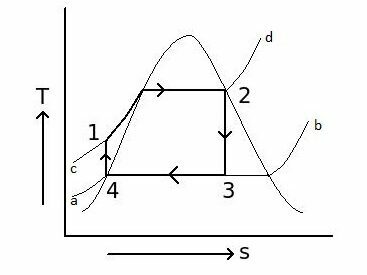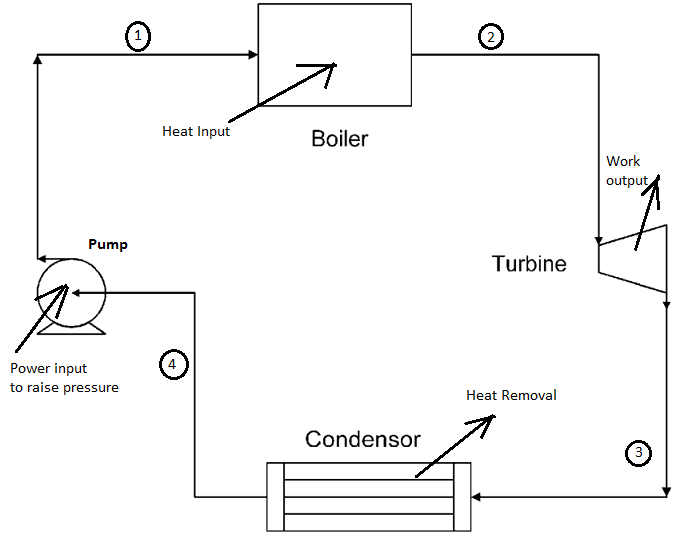
In Thermal power plants, the fuel (coal) is burnt to produce heat energy and this energy is later converted to electrical energy through a series of interlinked processes. It uses water as the working medium to first absorb heat energy from combustion of fuel and then extracting the heat energy from water to do turbine/shaft work. This rotational power is then used to generate electricity.
In this whole process, water undergoes various state changes and and it’s thermodynamic properties also keep changing as it passes from boiler to turbine and then to condenser and so on. These changes in properties of water due to absorption of heat and then release of heat, etc. is best depicted by Rankine Cycle. It is one of the most important thermodynamic cycles, as it is a practical cycle and finds application in thermal power plants.
Shown below is the Temperature-Entropy (T-S) diagram of Rankine cycle. The dome like structure is called the saturation dome. The region which lies left of the dome is the wet region, where water is in liquid state, while the region lying right of the dome is superheated zone, where the water is completely in vapour state. The region inside the dome represents the saturated water zone, where we can find a mixture of dry steam and water.

1-2: Constant pressure heat addition process.
The line ‘c-d’ is a constant pressure line. Water at state 1 is in liquid state. It absorbs heat from boiler and its temperature and entropy both rises until it enters the saturation dome. Inside the dome, phase change starts and water starts vapourizing. While vapourization takes place, heat is still being added, entropy increases but temperature remains constant. The heat, so absorbed, is called latent heat.
This process usually extends beyond the point ‘2’. In that case, it would follow the curve ‘c-d’ and the point ‘2’ would lie somewhere near the point ‘d’ as marked inthe diagram.
2-3: Isentropic Expansion Process.
Once it reaches the state ‘2’, the vapour is at high temperature and contains a lot of enthalpy (heat energy). It is now the right time to extract the heat back from it to drive the turbine. The steam is expanded in the turbine isentropically and its heat energy gets converted to shaft work. This shaft power can be used to drive the generator to produce electricity.
3-4: Constant pressure heat rejection process.
At the state ‘3’, i.e. at turbine exit, the state is well inside the saturation dome and hence the steam is wet saturated. It is then cooled in a condenser to bring it back to liquid state.
4-1: Isentropic pumping process.
At the state ‘4’, the water is in liquid condition, but its pressure is low. To continue the cycle, we must bring the water back to the boiler pressure. The boiler pressure is higher than the condenser pressure and hence, we pump the water from state ‘4’ to state ‘1’.

Thermal power plant is not the only type of power plant that uses the Rankine cycle. Many other power generation processes in fact, uses Rankine cycle. For example, in case of Nuclear Power plants and Solar Thermal plants, the same mechanism is used, with only change in the method of heat generation.
In Nuclear Power Plant, heat is generated by controlled fission chain reaction and in Solar thermal plants, Solar Collectors are used to generate steam instead of coal. Rest everything is identical to that of Thermal Power plant and they too, use the Rankine cycle for generation of electricity.